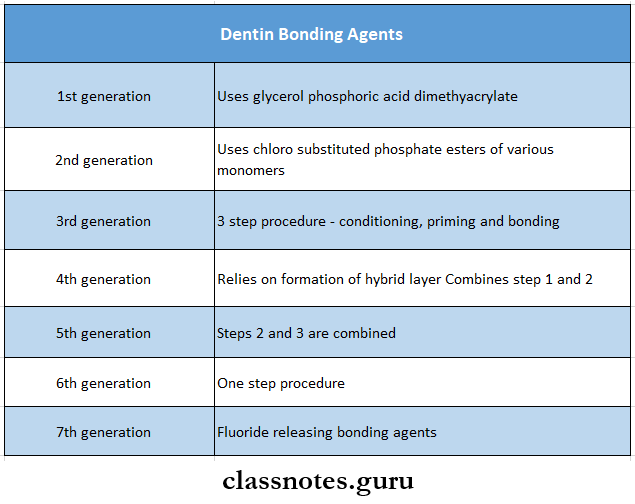Bonding Important Notes
1. Enamel Bonding
- Acid etching is done which results in the formation of resin tags
- Etchant used are
- Phosphoric acid – commonly 37% (37-50%)
- Maleic acid
- Citric acid
- Oxalic acid
- Concentration greater than 50% results in the formation of monocalcium phosphate monohydrate which prevents further dissolution
- Concentration below 30% results in dicalcium phosphate dehydration that cannot be easily removed
- The length of application of etchant is 15 sec
2. Dentin Bonding Steps
- Step 1 – etching or conditioning
- Conditioners are agents which aid in the removal or modification of the smear layer
- Example: EDTA, 10% phosphoric acid, citric acid, maleic acid
- Step 2 – application of primer
- Primers are monomers that are applied over the etched or conditioned surface for easy flow of bonding agents
- Example: HEMA, HEMA -2 dissolved in acetone or alcohol
- Step 3 – application of dentin bonding agents
Read And Learn More: Dental Materials Question and Answers
3. Dentin Bonding Agents
They are unfilled resins that help in the formation and stabilization of the hybrid layer

Bonding Short Essays
Question 1. Mechanism of etching in acid etch technique
Answer:
Mechanism Of Etching In Acid Etch Technique
- It creates microporosities by discrete etching of the enamel by selective dissolution of enamel rod centers or peripheries or both
- Etching increases the surface area
- Etched enamel has a high-risk surface energy allowing the resin to wet the tooth surface better
- It penetrates microporosities
- When polymerized it forms resin tags which form a mechanical bond to the enamel
Question 2. Pit And fissure sealants
Answer:
Pit And Fissure Sealants
Pit and fissure sealants are fluid materials that are applied in pits and fissures on the occlusal surfaces of molar and premolar teeth
Dynamics Of Machinery 3-1 Mechanical Engineering R16 Jntuk Exam Point Of View Preparation Notes
Pit And Fissure Sealants Classification:
1. Based On Polymerization
- Self-activation
- Light activation
2. Resin Systems
- BIS-GMA
- Urethane acrylate
3. Clear Or Tinted
Pit And Fissure Sealants Ideal Properties
- Easily flowable into the deep pit and fissures.
- Should result in prolonged adhesion to enamel
- Must have cariostatic properties
- Must be non-irritant
- Should have wear resistance property
Pit And Fissure Sealant Indications:
- Children of less than 4 years of age
- Newly erupted teeth
- Stained pits and fissures
Pit And Fissure Sealant Contraindications:
- Low caries risk patients
- Wide pit and fissures
- Partially erupted teeth
Pit And Fissure Sealants Method Of Application:
- Clean the tooth surface
- Wash and dry the selected teeth
- Etch the tooth with 37% phosphoric acid for 15 sec.
- Wash off with water for 30 sec
- Air-dry it to obtain a frosted appearance
- Re-etch if required
- Apply the sealant
- Cure it
Pit And Fissure Sealants Materials Used:
- Resin- BIS-GMA
- Urethane acrylate
- Fuji 7 GIC
- Teethmate- fluoride-releasing sealant
- 3M concise- light cure white sealant
- Amorphous calcium phosphate-releasing sealant
- Enamel LOC
- Embrace, wet bond

Best Dental Adhesives For Bonding
Question 3. Acid etch technique
Answer:
Acid Etch Technique
- It is the process of increasing the surface reactivity by demineralizing the superficial calcium layer and thus creating enamel tags
- These tags help in micro-mechanical bonding between the tooth and restorative resin
Acid Etch Technique Mechanism:
- Cleanses debris
- Increases enamel surface area
- Produces micropores for mechanical interlocking
- Exposes more reactive surface layer
Acid Etch Technique Factors Effecting It:
- Form of acid-gel
- The concentration of acid- 37% phosphoric acid
- Time-15-20 sec
- Chemical nature of enamel
- Type of dentition
Acid Etch Technique:
- Oral prophylaxis
- Isolate the tooth
- Application of etchant for 15 seconds
- Rinse thoroughly for 5-10 seconds
- Dry it which results in a frosty, white appearance
- Apply enamel bonding
- Agents
Question 4. Dentin bonding agents
Answer:
Dentin Bonding Agents
- Dentin bonding agents have both hydrophilic and hydrophobic ends
- The hydrophilic end displaces dentinal fluid while the hydrophobic end bonds to the composite resin

Composite Bonding Materials In Dentistry
Bonding Short Question And Answers
Question 1. Pit and fissure sealants
Answer:
Pit And Fissure Sealants
Pit and fissure sealants are fluid materials that are applied in pits and fissures on the occlusal surfaces of molar and premolar teeth
Pit And Fissure Sealants Classification:
1. Based On Polymerization
- Self-activation
- Light activation
2. Resin Systems
- BIS-GMA
- Urethane acrylate
3. Clear or tinted
Pit And Fissure Sealants Method Of Application:
- Clean the tooth surface
- Wash and dry the selected teeth
- Etch the tooth with 37% phosphoric acid for 15 sec
- Wash off with water for 30 sec
- Air-dry it to obtain a frosted appearance
- Re-etch if required
- Apply the sealant
- Cure it
Question 2. Sandwich technique
Answer:
Sandwich Technique
- Developed by Mclean et al in 1985
- Refers to a laminated restoration using glass ionomer to replace dentin and composite to replace enamel
- Composite bonds micromechanically to set GIC and chemically to the HEMA
Sandwich Technique:
- Isolate the tooth
- Tooth preparation
- Butt joint
- Beveling of enamel margin
- Pulp protection using calcium hydroxide
- Tooth conditioning using polyacrylic acid
- Placement of GIC
- Etching of GIC surface
- Coating with a dentin bonding agent
- Placement of composite and curing
- Finishing and polishing
Sandwich Technique Indications:
- Lesions where one or more margins are in dentin, for Example., cervical lesions.
- Class 1 composite restorations.
How Long Does Dental Bonding Last
Question 3. Acid etch technique
Answer:
Acid Etch Technique:
- Oral prophylaxis
- Isolate the tooth
- Application of etchant for 15 seconds
- Rinse thoroughly for 5-10 seconds
- Dry it which results in a frosty, white appearance
- Apply enamel bonding agents
